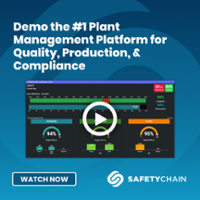The Critical Steps a Remote Audit Must Include
The COVID-19 virus has changed the way we live and do business, but it hasn’t changed the fact that food and beverage producers still need to maintain their food safety certifications to sell to their customers — and to make sure their suppliers are doing the same. Recently, certification progress has been stalled due to travel restrictions and tighter visitation policies. Without an end date in sight to new, stricter, visitation limitations, it is difficult to know when the next in-person audits will be possible. Fortunately, Eurofins’ Food Assurance division has teamed with SafetyChain to make remote auditing a viable alternative to onsite visits, allowing food and beverage companies to move forward with their routine certification process and mitigate the potential risks while waiting for restrictions to lift.
Although remote certification audits vary only slightly from onsite visits, there are a few key differences. Here are tips to help you successfully prepare for your first remote audit.
For the most part, a remote certification audit will entail the same steps an onsite audit would, including a records review, employee interviews, and process inspections.
- Notify Eurofins regarding your need for a remote audit.
- Conduct a self-assessment. This will include questions about your programs, facility, processes, and any changes that have been made since your last audit.
- Eurofins will review and respond to your self-assessment and determine if the audit can be performed remotely.
- Upload required documents. Eurofins will inform you which documents are needed.
- Under go the remote audit. The checklist will be viewable online by the appropriate parties.
- Receive audit recommendations. Certification can be granted based on a successful audit, or in some cases, a future onsite audit may be needed.
How to Prepare for Your Remote Audit
Once you’ve determined that a remote audit is right for your facility, there are several ways you can prepare to ensure the process runs smoothly.
- Identify key personnel and ensure availability. The same people who would normally support an onsite audit should be involved in your remote audit.
- Gather all documentation needed from the auditor. Don’t forget to ask for NDAs and make sure to provide procedural forms, like your visitor’s policy, ahead of time.
- Check the Internet connection. If needed, work with your IT team to make sure your internet can support the entire audit. Have a contingency plan in place in case you experience difficulties.
- Get clarity on the audit team’s process and needs. You may want to familiarize yourself with their preferred video conferencing tool (Webex, GoToMeeting, Zoom, etc).
- Digitize documents ahead of time. Scan in any necessary paper documents in advance to make sure they’re ready to be shared electronically.
Tips for Working with Remote Auditors

Remote auditing is a new process for auditors and facility managers alike, and it is likely to remain a common practice even after COVID-19 concerns begin to dissolve. As auditors transition to performing their jobs remotely, there are helpful steps food manufacturers can take to accelerate the learning curve on both sides.
- Have the right technology, like webcams or video-recording capabilities.
- Stay calm and be patient.
- Find a quiet environment with minimal background noise and interruptions.
- Perform a test drive of the applications needed for your remote audit.
Sign Me Up
Join our list to get Industry Webinars Invites, E-Guides, Customer Success Stories, and More.

